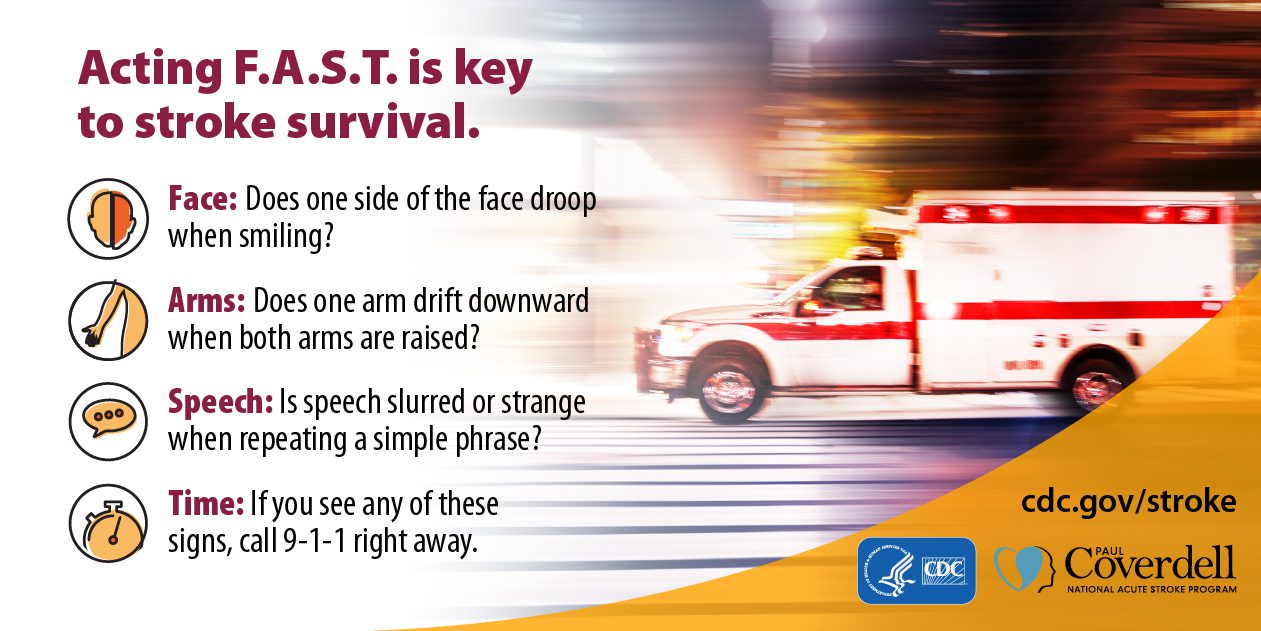May is National Stroke Awareness Month
Every 40 seconds, someone in the U.S. has a stroke.
It can happen any time, at any age!
When it comes to stroke, every minute counts. Acting F.A.S.T. (Face. Arms. Speech. Time.) can help stroke patients get the treatment they need to survive and reduce damage to the brain. This page will help you understand the basics of stroke, including signs and symptoms, and the importance of a F.A.S.T. response during a stroke,
What is a Stroke?
Many people think a stroke happens in the heart, but it actually happens in the brain.
A stroke occurs when the blood supply to part of your brain is interrupted or reduced, preventing brain tissue from getting oxygen and nutrients. Brain cells begin to die in minutes.
Stroke is a disease that affects the arteries leading to and within the brain. It is the number 5 cause of death and a leading cause of disability in the United States.
Nearly half of adults with high blood pressure are women. Women also have unique risks for high blood pressure — pregnancy, birth control and menopause — increasing stroke risk. Measuring blood pressure regularly may help lower your risk.
Anyone can have a stroke, and everyone should be prepared.
Risk Factors
You can’t control some risk factors for stroke, so it’s important you know them and talk to your doctor about them.
Age
The likelihood of having a stroke increases with age for both males and females. Although stroke is more common among the elderly, a lot of people under 65 also have strokes. Even babies and children can have a stroke.
Prior Stroke, TIA or Heart Attack
A person who has had a prior stroke has a much higher risk of having another stroke than a person who has never had one. A person who’s had one or more transient ischemic attacks (TIAs) is almost 10 times more likely to have a stroke than someone of the same age and sex who hasn’t. TIAs are smaller, temporary blockages in the brain that can produce milder forms of stroke-like symptoms but may not leave lasting damage. A TIA is a medical emergency. So follow up immediately with a healthcare professional.
If you’ve had a heart attack, you’re at higher risk of having a stroke. A heart attack is caused by plaque buildup that blocks blood vessels to the heart. Similarly, most strokes are caused by a buildup of plaque that cause blockages in the brain.
Family History
If your parent, grandparent, sister or brother has had a stroke — especially before reaching age 65 — you may be at greater risk. Sometimes strokes are caused by genetic disorders like CADASIL, which can block blood flow in the brain.
Gender
Women have more strokes than men and stroke kills more women than men. Women tend to live longer than men and are older when they have a stroke. Factors that may increase stroke risks for women include pregnancy, history of preeclampsia/eclampsia or gestational diabetes, oral contraceptive use (especially when combined with smoking) and post-menopausal hormone therapy. Be sure to discuss your risks with your doctor.
Race
African-Americans have a much higher risk of death from a stroke than Caucasians do. This is partly because blacks have higher risks of high blood pressure, diabetes and obesity. Hispanics and Latinos also have unique risks for stroke.
Acting F.A.S.T. Is Key for Stroke
Acting F.A.S.T. can help stroke patients get the treatments they desperately need. The stroke treatments that work best are available only if the stroke is recognized and diagnosed within 3 hours of the first symptoms. Stroke patients may not be eligible for these if they don’t arrive at the hospital in time.
If you think someone may be having a stroke, act F.A.S.T. and do the following simple test provided by the CDC:
F - Face
Ask the person to smile. Does one side of the face droop?
A - Arms
Ask the person to raise both arms. Does one arm drift downward?
S - Speech
Ask the person to repeat a simple phrase. Is the speech slurred or strange?
T - Time
If you see any of these signs, call 9-1-1 right away.

Recognize the Signs and Symptoms of Stroke
When someone is having a stroke, every minute counts. If you learn how to recognize the telltale signs of a stroke, you can act quickly and save a life—maybe even your own. Watch this video provided by the CDC:

